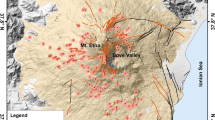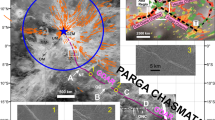Abstract
The criterion for fracture propagation suggests that the primary magma generated in the mantle ascends in a stepwise fashion. Initially a pulse of magma forms a dyke above the mantle source and ascends for some distance, whereafter it stops. A subsequent pulse of magma joins the first one, and the ascent of the accumulating body of magma continues for some distance each time a new pulse of magma reaches the body of magma situated in the top of the dyke. In this manner a dyke is formed that may extend either partly or the whole way from the mantle source to the surface. This model may explain the large pressures, up to 2000 bars, that prevail during basaltic eruptions. The calculated shape of the ascending pulses of magma suggests that their heights and widths are similar.
Similar content being viewed by others
References
Anderson EM (1972) The dynamics of faulting. Hafner Pub Co, New York, p 206
Atkinson BK (1984) Subcritical crack growth in geological materials. J Geophys Res 89 B6:4077–4114
Barenblatt GI (1962) The mathematical theory of equilibrium cracks in brittle fracture. Adv Appl Mech 7:55–129
Beer FR, Johnston ER (1981) Mechanics of materials. McGraw-Hill, New York, p 616
Carter NL, Ave'Lallement HG (1970) High temperature flow of dunite and peridotite. Geol Soc Am Bull 81:2181–2202
Cashman KV (1986) Crystal size distribution in igneous and metamorphic rocks (Ph D dissertation). John Hopkins University, Baltimore, p 345
Daly RA (1933) Igneous rocks and the depths of the Earth. McGraw-Hill, New York, p 598
Delaney PT, Pollard DD (1981) Deformation of host rocks and flow of magma during growth of minette dikes and brecciabearing intrusions near Ship Rock, New Mexico. US Geol Surv Prof Pap 1202:61
Dugdale DS (1960) Yielding of steel sheets containing slits. J Mech Phys Solids 8:100–108
Eaton JP, Murata KJ (1960) How volcanoes grow. Science 132:925–938
Gregory R (1984) Melt percolation beneath a spreading ridge: evidence from the Semail peridotite, Oman. In: Gass IG, Lippard SJ, Shelton AW (eds) Ophiolites and oceanic lithosphere. Blackwell, Oxford, pp 55–62
Griffith AA (1921) The phenomena of rupture and flow in solids. Philos Trans R Soc London Ser A221:163–198
Griggs DT, Turner FJ, Heard HC (1960) Deformation of rocks at 500° C to 800° C. In: Rock deformation. Geol Soc Am Mem 79, 39–104
Hellan K (1984) Introduction to fracture mechanics. McGraw-Hill, New York, p 302
Hubbert MK (1937) Theory of scale models as applied to the study of geologic structures. Bull Geol Soc Am 48:1459–1486
Irvin GR (1958) Fracture, Handbuch der Physics VI. Springer, Berlin Heidelberg New York, pp 551–590
Jaeger JC, Cook NGW (1969) Fundamentals of rock mechanics. Methuen & Co, London, p 513
Kausch HH, Kassel JA, Jaffel RI (1973) Deformation and fracture of high polymers. Plenum Press, London New York, p 644
Lubahn JD, Felgar RP (1961) Plasticity and creep of metals. John Wiley & Sons, New York, p 608
Maaløe S (1973) Temperature and pressure relations of ascending magmas. J Geophys Res, pp 6877–6886
Maaløe S (1985) Principles of igneous petrology. Springer, Berlin Heidelberg New York Tokyo, p 374
Maaløe S, Hansen B (1982) Olivine phenocrysts of Hawaiian olivine tholeiite and oceanite. Contrib Mineral Petrol 81:203–211
MacDonald GA, Abbot AT (1979) Volcanoes in the sea. Univ Press of Hawaii. Honolulu, p 441
Marsh BD (1982) On the mechanics of igneous diapirism, stoping, and zone melting. Am J Sci 282:808–885
Marsh BD (1984) Mechanics and energetics of magma formation and ascention. In: Boyd FR (ed) Studies in geophysics. National Acad Press, Washington, pp 67–83
Mavko GM, Nur A (1978) The effect of nonelliptical cracks on the compressibility of rocks. J Geophys Res 83:4459–4468
Olesiak Z (1968) Plastic zone due to thermal stress in an infinite solid containing a penny-shapes crack. Int J Eng Sci 6:113–125
Olesiak Z, Shadley JR (1969) Plastic zone in a thick layer with a disc-shaped crack. J Frac Mech 5:305–313
Olesiak Z, Wnuk M (1968) Plastic energy dissipatation due to a penny-shaped crack. J Frac Mech 4:383–396
Parker AP (1981) The mechanics of fracture and fatigue. E & FN Spon Ltd, London, p 167
Parton VZ, Morozov EM (1978) Elastic-plastic fracture mechanics. MIR Pub, Moscow, p 427
Pollard DD, Muller O (1976) The effect of gradients of regional stress and magma pressure on the form of sheet intrusions in cross section. J Geophys Res 81:975–984
Savin GN (1961) Stress concentration around holes. Pergamon Press, New York, p 430
Shaw HR (1980) The fracture mechanisms of magma transport from the mantle to the surface. In: Hargraves RB (ed) Physics of magmatic processes. Princeton Univ Press, Princeton, pp 201–264
Sneddon IN (1951) Fourier Transforms. McGraw-Hill, New York, p 542
Spence DA, Turcotte DL (1985) Magma-driven propagation of cracks. J Geophys Res 90:575–580
Trescher RW, Smith FW (1973) The partially closed Griffith crack. J Frac Mech 9:33–41
Weertman J (1971) Theory of water-filled crevasses in glaciers applied to vertical magma transport beneath the ridges. J Geophys Res 76:1171–1183
Wilson L (1980) Relationships between pressure, volatile content and ejecta velocity in three types of volcanic explosion. J Vol Geotherm Res 8:297–313
Author information
Authors and Affiliations
Rights and permissions
About this article
Cite this article
Maaløe, S. The generation and shape of feeder dykes from mantle sources. Contr. Mineral. and Petrol. 96, 47–55 (1987). https://doi.org/10.1007/BF00375524
Received:
Accepted:
Issue Date:
DOI: https://doi.org/10.1007/BF00375524




